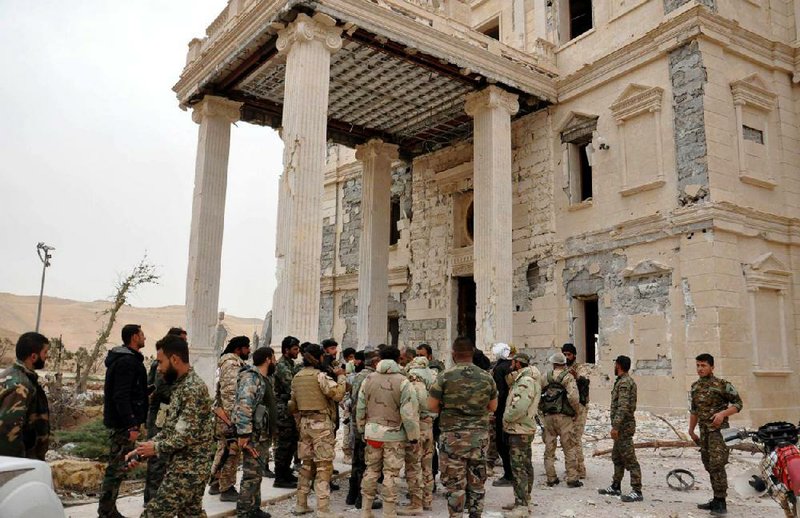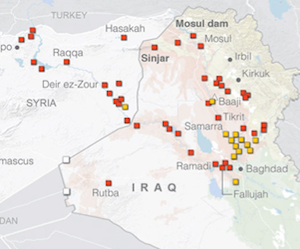BEIRUT -- Islamic State militants recaptured the ancient city of Palmyra from Syrian troops Sunday, according to both sides in the battle, after a year of setbacks in Syria and neighboring Iraq.
In winning back Palmyra, the extremist group appeared to be taking advantage of the Syrian and Russian preoccupation with Aleppo, timing its attack to coincide with a government offensive to capture the last remaining opposition-held neighborhoods in the northern city.
Palmyra, with its towering 2,000-year-old ruins, holds mostly symbolic meaning in the wider civil war, although its location in central Syria also gives it some strategic significance.
Islamic State militants re-entered the city Saturday for the first time since they were expelled by Syrian and Russian forces nine months ago. The government's win against the Islamic State in the city gave Damascus the chance to try to position itself as part of the global anti-terrorism campaign.
The militants had spent 10 months in Palmyra, during which they blew up a number of temples and caused other destruction -- severing the heads of statues and partially damaging two temples and a famous arch.
Maamoun Abdulkarim, Syria's official for antiquities and museums, said his department had transferred the contents of Palmyra's museum to Damascus, but that he still worries about the safety of the ruins from the Islamic State militants.
"I fear they will be more vengeful," Abdulkarim said.
Palmyra was a major tourist attraction before Syria's civil war began in 2011. It was built as a tribute to the visiting Roman emperor Septimius Severus more than 2,000 years ago. The Islamic State, also known by the acronym ISIS, ruled it with an iron fist, repurposing an iconic amphitheater as a stage for executions and enacting brutal punishments against residents who broke laws it imposed.
Sunday's takeover came hours after government troops and Russian air raids pushed the group out of the city's perimeter. Islamic State militants later regrouped and attacked from multiple sides, forcing government troops to retreat.
The militants went door to door, looking for any remaining forces loyal to President Bashar Assad, opposition activists in the city said.
Homs provincial Gov. Talal Barazi told the pan-Arab Mayadeen news channel that the Islamic State attack on Palmyra is a "desperate" reaction to the Syrian government's recent military "victories."
Scores of Syrian troops reportedly have been killed in fighting around Palmyra in recent days. While a distraction from the battle for Aleppo, it is unlikely to affect the government's final push on the last rebel-held neighborhoods in the northern city. By Sunday evening, there was no sign the army was shifting significant resources from Aleppo.
The government and its allies reportedly have mobilized about 40,000 fighters for Aleppo.
"I don't think the regime would withdraw forces from Aleppo to Palmyra and risk losing Aleppo," said Rami Abdurrahman, the head of the Syrian Observatory for Human Rights, an opposition monitoring group. "I think the regime's priority now is to finish the battle for Aleppo before the end of the month for sure. As for Palmyra, the whole international community would stand by it against [the Islamic State]."
Soft Target for ISIS
In the last year, the Islamic State has suffered defeats in both Syria and Iraq, losing several towns and cities it had captured in 2014.
The militants are now under attack in Mosul, Iraq's second-largest city and the last major urban center they control in the country. Since the Mosul offensive began nearly two months ago, Iraqi and U.S.-led coalition forces have killed or gravely wounded more than 2,000 Islamic State fighters, said Lt. Gen. Stephen Townsend, the top U.S. commander in Iraq. He made his remarks at a news conference with U.S. Defense Secretary Ashton Carter at Qayara air base in Iraq.
On Saturday, Carter announced that he is sending another 200 troops to Syria to train and advise local fighters battling the Islamic State. There are already 300 U.S. troops authorized for the Syria effort, and about 5,000 in Iraq.
A Kurdish-led Syrian force, backed by the U.S., is also pushing toward Raqqa, the group's self-described capital in Syria, from the north. Meanwhile, Turkey is backing Syrian opposition fighters who have reached the outskirts of al-Bab, an Islamic State stronghold in northern Syria.
In going for Palmyra, the Islamic State picked a soft target to demonstrate that it retains the ability to carry out large attacks despite its battlefield losses.
Mohammed Hassan al-Homsi, who runs the Palmyra News Network, said the Islamic State was steering away from northern Syria, where Turkey and the anti-Islamic State international coalition have focused their fight. The militants are eyeing new territory, and they chose Palmyra for its desert terrain linked to Iraq and its surrounding oil and gas fields, al-Homsi said.
The state-run Syrian Arab News Agency, quoting an unidentified military official, reported that the militant group received reinforcements from Raqqa.
Russia's Defense Ministry put some of the blame on the coalition, saying it had scaled down its operation against Raqqa and allowed thousands of Islamic State fighters to escape Mosul. The ministry said more than 4,000 militants have been deployed for the Palmyra takeover, suggesting that those attacking the city recently had left Mosul.
The Observatory and the Palmyra Coordination group said Islamic State militants used a multipronged attack, forcing government forces to retreat south. A map distributed by the Observatory shows the Islamic State-controlled areas extend east, south and north of Palmyra. They encompass a number of strategic hills around the city and expand the group's presence in rural parts of Homs province, Syria's largest, which is mostly under government control.
Osama al-Khatib of the activist-run Palmyra Coordination group, which keeps in touch with residents, said remaining government and allied troops were escaping from the southwestern edge of Palmyra, where the ancient ruins are. The few remaining families also are trying to leave, he said.
Palmyra News Network said intense airstrikes followed the Islamic State takeover. The group said the Islamic State fired on fleeing civilians.
In a video released by the Islamic State-linked Aamaq news agency, fighters were shown roaming a main square that appeared deserted below the citadel that overlooks the ruins and the Palmyra Museum.
Russia had earlier said it repelled an Islamic State attack, launching 64 airstrikes overnight that killed 300 militants. But hours later, the activists said the Islamic State had seized a castle just outside the town that overlooks its famed Roman-era ruins.
Expelling the Islamic State militants from Palmyra last year was seen as a major triumph for Assad's forces, which previously had little success against the extremists.
The government and its Russian allies have since focused on the opposition in Damascus and Aleppo. After tightening the siege on eastern Aleppo, government and allied troops have been steadily carving into the rebel-held enclave since late November.
Of the original 17 square miles of rebel-held area, only 4 square miles remain in opposition hands, Syrian media said.
Last bridge hit in Aleppo
Hundreds of Syrians stood in long lines Sunday, some getting on government buses, to flee the ever-shrinking, rebel-held enclave of eastern Aleppo as military troops and allied militias continued their push to regain full control of the opposition stronghold.
The Syrian Arab News Agency reported that at least 4,000 people fled the enclave Sunday. The state TV channel said more than 70,000 of eastern Aleppo's estimated 275,000 residents have fled in recent days -- mostly to government-held western Aleppo districts.
Residents said government airstrikes hit the last remaining bridge that linked eastern and western Aleppo, a largely symbolic strike. They also reported that government and allied troops kept up their bombing of a handful of neighborhoods, which have become the shelter for most of the civilians who chose to remain.
"There is not a building that remains standing," said Mohammed Khandaqani, a medical administrator who remains in Aleppo, speaking of his neighborhood, al-Maadi, near the old city. He said government troops have advanced there, and others said most of the newly displaced residents left from that area. "This scorched-earth policy is truly overwhelming."
State TV on Sunday showed hundreds of Syrian men gathering, apparently to leave eastern Aleppo, while some women were getting on the buses. The images from the exit routes, which have also been broadcast live by the Russian military, have been playing nearly every day since the ground offensive began dislodging opposition fighters bit by bit from eastern Aleppo neighborhood starting from the north.
The swift Russia-backed ground offensive, which began Nov. 26, followed an intensive aerial bombing campaign that knocked out most of the medical facilities, targeted civil defense and municipal vehicles and blocked roads with rubble. The eastern Aleppo area has also been cut off from outside assistance since July by a government siege.
Information for this article was contributed by Sarah El Deeb, Zeina Karam, Howard Amos, Vladimir Isachenkov, Albert Aji and Robert Burns of The Associated Press and by Louisa Loveluck, Liz Sly, Suzan Haidamous, Zakaria Zakaria and David Filipov of The Washington Post.
A Section on 12/12/2016

